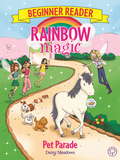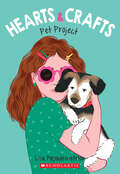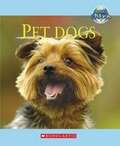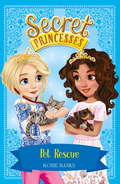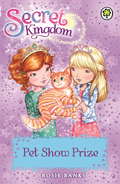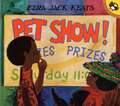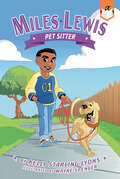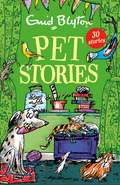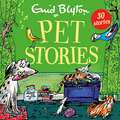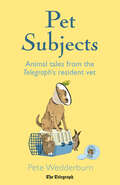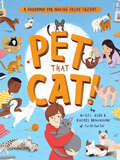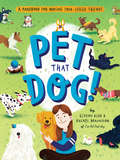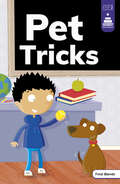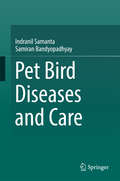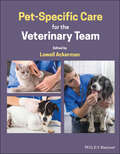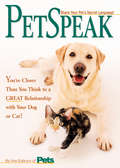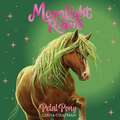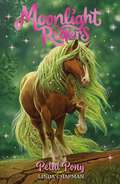- Table View
- List View
Pet Parade: Book 8 (Rainbow Magic Beginner Reader #8)
by Daisy MeadowsLearning to read is fun with the Rainbow Magic Fairies! Developed in conjunction with Early Years reading consultants and based on the most up-to-date educational research, the Rainbow Magic Beginner Readers are the perfect way to introduce your child to the magical world of reading.
Pet Parrots (Nature's Children)
by Frank PuccioWhat can compare with the sight of a large, beautiful bird flying through the air or landing--brightly colored wings stretched out--on a branch? Birds, with their colors and flight, have fascinated people for thousands of years. The ancient Egyptians had gods who were birds. The ancientGreeks told tales of daredevils who tried to add wings and feathers to their bodies. And for hundreds of years inventors of all nations worked to create machines that would allow humans to fly like the birds. Of all the birds of the world few are as colorful and as fascinating as parrots. Beautiful, affectionate, and full of individual personality, they even are clever enough to talk. It's no wonder that for hundreds of years they have been among the world's most treasured pets and companions.
Pet Problem! (Pictureback(R))
by David LewmanTrolls—the most magical creatures with the wildest hair—experience hilarious problems when a pet grows way too big in this book! From the makers of Shrek, DreamWorks Trolls is the hair-raising comedy filled with unbelievable adventure, incredible music, and Trolls, the joyous creatures with crazy, colorful, magical hair! Poppy brings a new pet to the pet nursery, but chaos and fun ensue when the pet proves to be too big for Poppy . . . and the other Trolls. This full-color storybook for boys and girls 3 to 7 features favorite characters from the hit movie.
Pet Project (Hearts & Crafts #2)
by Lisa PapademetriouMackenzie always makes it work -- even when the project is a furry fiasco!When Mackenzie Miller’s aunt needs a foster home for one of the dogs at her shelter, Mackenzie jumps at the chance. Buster is so sweet and cuddly, and Mackenzie is sure he’ll cheer up her stressed-out mom. And helping Buster find a forever home? Mackenzie loves a project!Buster is an older dog who acts like a puppy -- which, it turns out, means he’s a lot of work. Mackenzie wants to be the best foster mom ever, but she also has school; and her best friend, Sheera, needs help reconciling with her cousin, Yasmin; and her mom has just gone from overworked to unemployed. And Buster just keeps -- well, busting up Mackenzie’s plans! Can she make it work, like she always does? Or has Mackenzie bitten off more than she can chew?
Pet Rabbits (Nature's Children)
by Amy-Jane BeerDescribes the physical features, care, history, and selection of a pet rabbit.
Pet Reptiles (Nature's Children)
by Daniel NoonanDescribes the physical characteristics, natural habitat, behavior, diet, world distribution, domestic types, and care required of these animals sometimes used as pets.
Pet Rescue: Book 15 (Secret Princesses #15)
by Rosie BanksA magical new series where best friends become Secret Princesses! Best friends Charlotte and Mia can't bear it when Charlotte's family moves far away. But when they become trainee Secret Princesses they begin an amazing adventure together - and they can see each other whenever they like!Once in a blue moon, a tiara shaped constellation forms high in the sky above Wishing Star Palace. The four girls that make a wish on these special stars get their wishes granted by the Secret Princesses ... but Princess Poison is determined that this year the wishes won't come true ...Have you read all four books in series four: The Moonstone Collection?
Pet Show Prize: Book 29 (Secret Kingdom #29)
by Rosie BanksJasmine, Summer and Ellie are so excited to meet Pinky the Animal Elf and all her pet friends. But Queen Malice has taken away Summer's talent with animals! When Queen Malice casts a spell to transform Pinky, the girls must work out which creature she is and award her the Pet Show Prize before it's too late!
Pet Show!
by Ezra Jack KeatsWhen he can't find his cat to enter in the neighborhood pet show, Archie must do some fast thinking to win a prize.
Pet Show! (Reading Rainbow Book)
by Ezra Jack KeatsHow can you enter a pet show when your pet runs away? That's the question Archie faces when he can't find his cat to enter in the neighborhood pet show. Fortunately, he does some fast thinking to win a prize in this beloved classic from award-winning author-illustrator Ezra Jack Keats.
Pet Sitter #5 (Miles Lewis)
by Kelly Starling LyonsFrom the award-winning author of the Jada Jones chapter books comes an illustrated spin-off series perfect for STEM fans!When Miles and his classmates welcome a few frogs as class pets, it's a reminder that what he really wants more than anything is a dog to call his own. But his parents don't think he's ready, and his attempts to show them that he truly can care for critters all end in disaster. Can Miles pull it together and prove that he's responsible enough for a pet once and for all?
Pet Stories
by Enid BlytonA wonderful new collection of short stories about our favourite fluffy friends, from national treasure Enid BlytonEnjoy 30 charming tales about cats, dogs, budgies, rabbits and other adored family pets in this fantastic new bumper collection. Enid Blyton, author of The Famous Five, loved dogs and other animals. Her perfectly crafted short stories about children and their pets are ideal for young readers to enjoy alone or as read-aloud stories in the classroom or at bedtime. Ideal for children aged 5 and over.
Pet Stories (Bumper Short Story Collections #65)
by Enid BlytonA wonderful new collection of short stories about our favourite fluffy friends, from national treasure Enid BlytonEnjoy 30 charming tales about cats, dogs, budgies, rabbits and other adored family pets in this fantastic new bumper collection. Enid Blyton, author of The Famous Five, loved dogs and other animals. Her perfectly crafted short stories about children and their pets are ideal for young readers to enjoy alone or as read-aloud stories in the classroom or at bedtime. Ideal for children aged 5 and over.
Pet Stories (Bumper Short Story Collections #65)
by Enid BlytonA wonderful new collection of short stories about our favourite fluffy friends, from national treasure Enid BlytonEnjoy 25 charming tales about cats, dogs, budgies, rabbits and other adored family pets in this fantastic new bumper collection. Enid Blyton, author of The Famous Five, loved dogs and other animals. Her perfectly crafted short stories about children and their pets are ideal for young readers to enjoy alone or as read-aloud stories in the classroom or at bedtime. Ideal for children aged 5 and over.(P)2021 Hodder & Stoughton Limited
Pet Subjects: Animal Tales from the Telegraph's Resident Vet
by Pete WedderburnPete the Vet has seen it all – whether Apollo the hamster, Nero the cat, Samson the rabbit or Ned the terrier, he has come across a whole host of cases that aren't in the textbook. With nearly twenty-five years at a veterinary clinic combined with ten years spent on the Telegraph answering reader's questions and a weekly spot on Irish breakfast TV he has dealt with sick pets from the big to the small. Whether that is a giant tortoise or a budgie, there is no case too extraordinary for Pete. Drawing on his experience from his own veterinary practice Pete has a wealth of stories – heart-warming as well as heartbreaking – that are told with a witty and engaging turn of phrase. Pet Subjects is a collection of case studies where the reader works beside Pete to try and cure his patients. Once solved, Pete helpfully provides further Q&As to cover a wider range of ailments related to the main story. A captivating and essential read for anyone who cares for a pet of their own.
Pet Tales: Extraordinary Pets From Ordinary Homes
by Anne CuthbertsonThis first collection of Pet Tales, compiled by former Life editor Anne Cuthbertson, features a talking dog and a surfboarding cat, a chicken that thinks it's human, a foul-tempered duck called Mussolini, a bear called Tina, and an escaped cornsnake who may still be at large under the floorboards. Readers will adore the cast of quirky, sympathetic, heroic and adorable characters, including Lovable Rogues, Timid Souls, Hunters and Gatherers, Escape Artists, Givers of Joy and Dearly Departed. With a foreword by the dog-lover, television presenter and adventurer Ben Fogle, this heart-warming, hilarious and at times heart-breaking book is a must for anyone who has ever loved a pet. The Pet Tales column of the Sunday Telegraph launched in 2010, giving readers the opportunity to send in their own stories and pictures. It quickly developed a devoted following with close to a thousand submissions to date.
Pet Tales: Extraordinary Pets From Ordinary Homes
by Anne CuthbertsonThis first collection of Pet Tales, compiled by former Life editor Anne Cuthbertson, features a talking dog and a surfboarding cat, a chicken that thinks it's human, a foul-tempered duck called Mussolini, a bear called Tina, and an escaped cornsnake who may still be at large under the floorboards.Readers will adore the cast of quirky, sympathetic, heroic and adorable characters, including Lovable Rogues, Timid Souls, Hunters and Gatherers, Escape Artists, Givers of Joy and Dearly Departed.With a foreword by the dog-lover, television presenter and adventurer Ben Fogle, this heart-warming, hilarious and at times heart-breaking book is a must for anyone who has ever loved a pet.The Pet Tales column of the Sunday Telegraph launched in 2010, giving readers the opportunity to send in their own stories and pictures. It quickly developed a devoted following with close to a thousand submissions to date.
Pet That Cat!: A Handbook for Making Feline Friends
by Rachel Braunigan Nigel KiddA fun and informative handbook for young readers on understanding and caring for our feline friends from the kid behind the popular Twitter account I&’ve Pet That Cat!Pet That Cat! A Handbook for Making Feline Friends is an illustrated guide to understanding, befriending, and caring for cats by Nigel Kidd and his mom, Rachel Braunigan. This fact-filled and fun guide features: • A guide to cat body language—what does it mean when your cat&’s tail looks like a question mark or is puffed up? • Helpful tips on how to safely interact with new feline friends. Hint: Let them approach first! • Advice for adopting and caring for your own cat. Choose the perfect cat for you! • Stories of cats throughout history and myth-busting facts—did you know every cat has a unique noseprint? • A cat personality quiz and your very own Cat Tracker to record all the feline friends you meet! This kid-friendly handbook pairs charming illustrations with an interactive format. With step-by-step guides, fascinating stories, and tips from cat experts and Nigel, Pet That Cat! is a must-have handbook for feline fans of all ages.And for dog-lovers and kids curious about dogs, check out Pet That Dog! A Handbook for Making Four-Legged Friends.
Pet That Dog!: A Handbook for Making Four-Legged Friends
by Gideon Kidd Rachel BrauniganFrom 11-year-old dog-loving Gideon Kidd of the viral Twitter account I've Pet That Dog comes a guide for young readers to befriend and care for dogs of all shapes, sizes, and personalities! Pet That Dog! A Handbook for Making Four-Legged Friends is an illustrated guide to meeting, petting, and caring for dogs by Gideon and his mom, Rachel Braunigan. Learn how dogs communicate through body language, helpful tips for safely interacting with dogs, and fun facts about dogs to share with friends. (Did you know that all-white dogs are more likely to be deaf? Or that dogs poop in alignment with the north-south axis of the Earth&’s magnetic field?) You can even keep track of the pups you meet with your very own Dog Tracker.With an interactive format and joyful illustrations of lovable dogs, Pet That Dog! makes a perfect gift for dog lovers and dog-curious kids.
Pet Tricks (Stairway Decodables Step 2)
by Leanna KochIt’s Pet Day at school! Ben and his friends are eager to show off their pets to the class. But things don’t go as planned when Ben shows his dog Rex’s trick. Stairway Decodables is a supplemental phonics resource that’s perfect for supporting small group instruction, independent reading, or reading practice at home. This title provides practice in decoding words with final consonant blends.
Pet bird diseases and care
by Indranil Samanta Samiran BandyopadhyayThis book provides fundamental information on pet birds, menaces, and advances made in the diagnosis and treatment of menaces. It is the only book covering all species of pet birds, menaces and their individual management. The handful of related books available worldwide are largely outdated and focus on a single species or breed of pet bird. The book encompasses the history of bird keeping, common breeds of birds, their nutritional requirements, list of zoonotic diseases transmitted by birds and guideline for their prevention. It covers infectious, non-infectious clinical and metabolic diseases, and toxicity in detail with a special focus on the history of diseases, etiology, affected hosts, pathogenesis, clinical signs, diagnosis and treatment. Separate chapters detail relevant diagnostic techniques, management and care practices, including updated information. The book offers an invaluable guide for students and teachers in the field of (avian) veterinary medicine, scientists/research scholars working in related fields, and avian medicine practitioners, as well as all those progressive bird owners who want to know the basics of their care and management.
Pet-Specific Care for the Veterinary Team
by Lowell AckermanA practical guide to identifying risks in veterinary patients and tailoring their care accordingly Pet-specific care refers to a practice philosophy that seeks to proactively provide veterinary care to animals throughout their lives, aiming to keep pets healthy and treat them effectively when disease occurs. Pet-Specific Care for the Veterinary Team offers a practical guide for putting the principles of pet-specific care into action. Using this approach, the veterinary team will identify risks to an individual animal, based on their particular circumstances, and respond to these risks with a program of prevention, early detection, and treatment to improve health outcomes in pets and the satisfaction of their owners. The book combines information on medicine and management, presenting specific guidelines for appropriate medical interventions and material on how to improve the financial health of a veterinary practice in the process. Comprehensive in scope, and with expert contributors from around the world, the book covers pet-specific care prospects, hereditary and non-hereditary considerations, customer service implications, hospital and hospital team roles, and practice management aspects of pet-specific care. It also reviews specific risk factors and explains how to use these factors to determine an action plan for veterinary care. This important book: Offers clinical guidance for accurately assessing risks for each patient Shows how to tailor veterinary care to address a patient’s specific risk factors Emphasizes prevention, early detection, and treatment Improves treatment outcomes and provides solutions to keep pets healthy and well Written for veterinarians, technicians and nurses, managers, and customer service representatives, Pet-Specific Care for the Veterinary Team offers a hands-on guide to taking a veterinary practice to the next level of care.
PetSpeak: Share Your Pet's Secret Language!
by The Editors of Pets: Part of the FamilyWhat is your pet trying to tell you? The best way to understand dogs and cats is to see the world through their eyes, and this book shows you how to do just that. Packed with expert advice, easy-to-follow training techniques, and real-life examples, PetSpeak is the only book you'll ever need to make your pet a fully responsive (and responsible) part of the family. Between these covers, you'll find eye-opening answers to hundreds of puzzling questions, such as:* Why does my dog sneak a drink from the toilet bowl when his own water dish is filled to the brim?* Why does my cat insist on walking on counters?* Why does my dog like rolling in smelly things so much?* Why does my cat suddenly scratch me while I'm petting her?Discover how to put an end to these perplexing behaviors, and:* Learn how to give commands so your dog will obey--the first time.* Uncover the secret meaning of incessant yawning, teeth chattering, and other signals.* Meet dozens of delightful, inspiring pets and people who have already mastered petspeak.
Petal Pony: Book 3 (Moonlight Riders #10)
by Linda ChapmanHarness the power of the elements with the Moonlight Riders! A brand-new series for young listeners from bestselling author Linda Chapman, author of MY SECRET UNICORN and UNICORN ACADEMY.Could you be a True Rider?When a huge storm damages the stables, Jill is worried that she'll have to close down the Moonlight Stables Riding School - permanently! Amara and the other True Riders are determined to not let that happen, and with the help of their elemental horses they set about to raise the money needed to repair the school. But on the night before their big fundraiser, Ivy storms the stables on her elemental horse and ruins all their hard work. The gang have only hours to fix the damage before their open day begins. What's worse is Rose is sick from using her earth magic to repair the stables. Can the friends find the magical flower they need to heal her and still make the fundraiser in time? The future of Moonlight Stables is in their hands!Don't miss the other Moonlight Riders stories!Fire HorseStorm StallionSea Foal(P) 2022 Hodder & Stoughton Limited
Petal Pony: Book 3 (Moonlight Riders #3)
by Linda ChapmanHarness the power of the elements with the Moonlight Riders! A brand-new series for young readers from bestselling author Linda Chapman, author of MY SECRET UNICORN and UNICORN ACADEMY.Could you be a True Rider?When a huge storm damages the stables, Jill is worried that she'll have to close down the Moonlight Stables Riding School - permanently! Amara and the other True Riders are determined to not let that happen, and with the help of their elemental horses they set about to raise the money needed to repair the school. But on the night before their big fundraiser, Ivy storms the stables on her elemental horse and ruins all their hard work. The gang have only hours to fix the damage before their open day begins. What's worse is Rose is sick from using her earth magic to repair the stables. Can the friends find the magical flower they need to heal her and still make the fundraiser in time? The future of Moonlight Stables is in their hands!Don't miss the other Moonlight Riders stories!Fire HorseStorm StallionSea Foal
